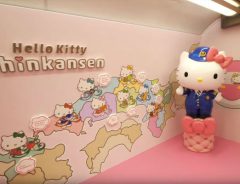- Source:
- Shiseido
Related Article
-

No Face Soy Sauce Bottle And Rice Paddle Are Here To Spirit Your Cooking Away
-

Top 7 Pancake Houses In Tokyo Serving The City’s Best Pancakes
-

Book A Trip To See The Onouchi Hyakkei Icicles For A Truly Majestic Experience
-

The Hello Kitty Bullet Train Fully Revealed In Japan
-

Japanese Company Inadvertently Creates Country’s Most Grotesque Gift Box
-

Japanese Service Rents Out Hot Guys To Show You Sad Movies Then Wipe Away Your Tears



In every country in the world, societal and cultural trends are constantly changing, and in Japan, a transition often examined has been in regards to beauty, makeup, and fashion. We've seen 100 years of Japanese beauty and fashion trends flash before our eyes in under two minutes, and observed the ever-changing concept of beauty itself showcased in a breathtaking project.
As one of Japan's leading makeup brands, it's safe to say that Shiseido has been a significant presence throughout the history of Japanese beauty trends. Taking their first-hand knowledge of the history of beauty trends in Japan, they've recently compiled a list of Japanese makeup trends enjoyed over the past century. Titled "Makeup Reflects the Times — The Transition of Japanese Women’s Makeup —," the company's Senior Hair & Makeup Artist Setsuko Suzuki explained in detail the various characteristics of makeup trends in Japan starting from the 1920s.
1920s
From the 1920s to the mid-1950s, makeup trends centered around the Japanese admiration for Western culture. Inspired by Western models, actresses, and other stars from the silver screen, makeup in the 1920s focused on a damsel-in-distress look that consisted of thin, sagging eyebrows, droopy eyes, and thin puckered lips. However, this look bore similarities to traditional Japanese makeup, making the transition rather natural.
Source: Shiseido
1930s
As Western influence grew stronger, women began to draw their eyebrows in a more arched fashion and overdraw their lips to make them look larger.
Source: Shiseido
1950s
By the 1950s, the look became bolder with thick, block eyebrows and lifted eyes. This change is said to be a reflection of the reconstruction phase of post-war Japan.
Source: Shiseido
1960s
The adoration of Western facial features continued throughout the 1960s and 70s, especially as Japan became fully aware of the rest of the world. Lip tones became softer, and people began to emulate models on TV commercials rather than movie stars.
Source: Shiseido
1970s
Large, sculpted eyes and long eyelashes became the trend, along with tanned skin tones, droopy eyes, and thin eyebrows.
Source: Shiseido
2nd Half of the 1970s
From the second half of the 1970s, there began a re-evaluation of Japanese beauty, and women began to break way from their inferiority complex toward Westerners.
Source: Shiseido
Early 1980s to Mid-1980s
As the economy boomed in the 1980s, women began to enjoy both "feminine" and "masculine" looks.
Source: Shiseido
Late 1980s to Early 1990s
Source: Shiseido
Late 1990s to Early 2000s
The late 1990s marked the beginning of an "aesthetic boom," which prompted the creation and evolution of trends unique to Japan. Women sought other means of aesthetic expression besides makeup, experimenting with new hairstyles and gel nail polish.
Source: Shiseido
Mid-2000s to Late 2000s
Source: Shiseido
Post-March 11, 2011 (Tōhoku earthquake and tsunami)
After the devastating earthquake and tsunami that hit the Tōhoku region, makeup trends in turn became more natural and toned down.
Source: Shiseido
Mid-2010s
In present-day Japan, the bolder look is making a comeback as the country welcomes the revival of the economic bubble.
Source: Shiseido
A more detailed analysis can be read on the Shiseido website, but what is clear is that makeup trends change as the social or economic milieu changes. When the economy picks up, lips tend to become bright and sharp, while eyebrows become thicker. When the economy slows down, eyebrows tend to be drawn thinner while more lukewarm colors are used. After disasters and/or political instability, makeup tends to return to a natural look.